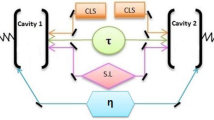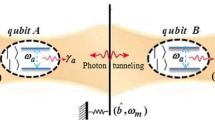Abstract
We have theoretically investigated an optomechanical system and presented the scenario of significantly enhanced bipartite photon–phonon entanglement for two qubits coupled to the single mode of the cavity. The results are compared with the one qubit case for reference. The tripartite atom–photon–phonon interaction is considered as only three-body resonant interaction, while the two-body actions are ignored under some potential approximations. Furthermore, we have studied the phenomenon of hyperradiance in which the well-known Dicke superradiant (\(N^2\) scaling law) can be surpassed due to the inter-atomic correlations. Jointly, a parameter regime is explored to observe the entanglement of photon–phonon pairs and their hyperradiance simultaneously. As it is important to show that the generation of photons and phonons is antibunched, the equal time second-order correlation function \(g^{(2)}(0)\) is characterized as witness. This system can be realized in Circuit Cavity Quantum Electrodynamics (CCQED) in which the direct coupling of the atom and mechanical resonator is possible.







Similar content being viewed by others
Data availability statement
As all data have been presented in the main text graphically, therefore this manuscript has no associated data information.
References
S. Barrett, K. Hammerer, S. Harrison, T.E. Northup, T.J. Osborne, Simulating quantum fields with cavity QED. Phys. Rev. Lett. 110, 090501 (2013)
A. Majumdar, M. Bajcsy, J. Vučković, Probing the ladder of dressed states and nonclassical light generation in quantum-dot–cavity QED. Phys. Rev. A 85, 041801 (2012)
I.J. Luxmoore, R. Toro, O.D. Pozo-Zamudio, N.A. Wasley, E.A. Chekhovich, A.M. Sanchez, R. Beanland, A.M. Fox, M.S. Skolnick, H.Y. Liu et al., III–V quantum light source and cavity-QED on silicon. Sci. Rep. 3, 1239 (2013)
S.K. Singh, Quantum dynamics and nonclassical photon statistics of coherently driven Raman transition in bimodal cavity. J. Mod. Opt. 66, 562 (2019)
Z. Haider, S. Qamar, M. Irfan, Multiphoton blockade and antibunching in an optical cavity coupled with dipole-dipole-interacting \(\lambda \)-type atoms. Phys. Rev. A 107, 043702 (2023)
K. Hou, C. Zhu, Y. Yang, G. Agarwal, Interfering pathways for photon blockade in cavity QED with one and two qubits. Phys. Rev. A 100, 063817 (2019)
S. Singh, J.-X. Peng, M. Asjad, M. Mazaheri, Entanglement and coherence in a hybrid Laguerre–Gaussian rotating cavity optomechanical system with two-level atoms. J. Phys. B Atomic Mol. Opt. Phys. 54, 215502 (2021)
X. Liang, Z. Duan, Q. Guo, S. Guan, M. Xie, C. Liu, Photon blockade in a bimode nonlinear nanocavity embedded with a quantum dot. Phys. Rev. A 102, 053713 (2020)
L.-L. Nian, B. Zheng, J.-T. Lü, Electrically driven photon statistics engineering in quantum-dot circuit quantum electrodynamics. Phys. Rev. B 107, L241405 (2023)
D.M. Lukin, M.A. Guidry, J. Yang, M. Ghezellou, S.D. Mishra, H. Abe, T. Ohshima, J. Ul-Hassan, J. Vučković, Two-emitter multimode cavity quantum electrodynamics in thin-film silicon carbide photonics. Phys. Rev. X 13, 011005 (2023)
J. Yang, M.A. Guidry, D.M. Lukin, K. Yang, J. Vučković, Inverse-designed silicon carbide quantum and nonlinear photonics. Light Sci. Appl. 12, 201 (2023)
A. Imamoglu, H. Schmidt, G. Woods, M. Deutsch, Strongly interacting photons in a nonlinear cavity. Phys. Rev. Lett. 79, 1467 (1997)
L. Zhang, C. Silberhorn, I.A. Walmsley, Secure quantum key distribution using continuous variables of single photons. Phys. Rev. Lett. 100, 110504 (2008)
S. Singh, M. Mazaheri, J.-X. Peng, A. Sohail, M. Khalid, M. Asjad, Enhanced weak force sensing based on atom-based coherent quantum noise cancellation in a hybrid cavity optomechanical system. Front. Phys. 11, 245 (2023)
X.-L. Wang, X.-D. Cai, Z.-E. Su, M.-C. Chen, D. Wu, L. Li, N.-L. Liu, C.-Y. Lu, J.-W. Pan, Quantum teleportation of multiple degrees of freedom of a single photon. Nature 518, 516 (2015)
M.-A. Lemonde, N. Didier, A.A. Clerk, Nonlinear interaction effects in a strongly driven optomechanical cavity. Phys. Rev. Lett. 111, 053602 (2013)
K. Stannigel, P. Komar, S. Habraken, S. Bennett, M.D. Lukin, P. Zoller, P. Rabl, Optomechanical quantum information processing with photons and phonons. Phys. Rev. Lett. 109, 013603 (2012)
M. Aspelmeyer, T.J. Kippenberg, F. Marquardt, Cavity optomechanics. Rev. Mod. Phys. 86, 1391 (2014)
W. Shao, J. Li, L.-L. Wang, Frequency conversion in a hybrid cavity-optomechanical system. Phys. Rev. A 107, 063505 (2023)
S. Singh, M. Asjad, C.R. Ooi, Tunable optical response in a hybrid quadratic optomechanical system coupled with single semiconductor quantum well. Quantum Inf. Process. 21, 47 (2022)
J. Cao, W.-X. Cui, X. Yi, H.-F. Wang, Controllable photon-phonon conversion via the topologically protected edge channel in an optomechanical lattice. Phys. Rev. A 103, 023504 (2021)
D. Vitali, S. Gigan, A. Ferreira, H. Böhm, P. Tombesi, A. Guerreiro, V. Vedral, A. Zeilinger, M. Aspelmeyer, Optomechanical entanglement between a movable mirror and a cavity field. Phys. Rev. Lett. 98, 030405 (2007)
M.J. Hartmann, M.B. Plenio, Steady state entanglement in the mechanical vibrations of two dielectric membranes. Phys. Rev. Lett. 101, 200503 (2008)
K. Borkje, A. Nunnenkamp, S. Girvin, Proposal for entangling remote micromechanical oscillators via optical measurements. Phys. Rev. Lett. 107, 123601 (2011)
S. Barzanjeh, M. Abdi, G.J. Milburn, P. Tombesi, D. Vitali, Reversible optical-to-microwave quantum interface. Phys. Rev. Lett. 109, 130503 (2012)
Y.-D. Wang, A.A. Clerk, Using interference for high fidelity quantum state transfer in optomechanics. Phys. Rev. Lett. 108, 153603 (2012)
L. Tian, Adiabatic state conversion and pulse transmission in optomechanical systems. Phys. Rev. Lett. 108, 153604 (2012)
T. Palomaki, J. Teufel, R. Simmonds, K.W. Lehnert, Entangling mechanical motion with microwave fields. Science 342, 710 (2013)
U. Akram, W. Munro, K. Nemoto, G. Milburn, Photon-phonon entanglement in coupled optomechanical arrays. Phys. Rev. A 86, 042306 (2012)
A. Lakhfif, J. El Qars, M. Nassik, Controlling photon-phonon entanglement in a three-mode optomechanical system. Eur. Phys. J. D 75, 189 (2021)
X.-W. Xu, H.-Q. Shi, J.-Q. Liao, A.-X. Chen, Generation of single entangled photon-phonon pairs via an atom–photon–phonon interaction. Phys. Rev. A 100, 053802 (2019)
M. Amazioug, B. Maroufi, M. Daoud, Enhancement of photon–phonon entanglement transfer in optomechanics. Quantum Inf. Process. 19, 1 (2020)
K. Araya-Sossa, M. Orszag, Generation of entanglement via squeezing on a tripartite-optomechanical system. Phys. Rev. A 108, 012432 (2023)
T. Dekorsy, G.C. Cho, H. Kurz, Coherent Phonons in Condensed Media, Light Scattering in Solids VIII: Fullerenes, Semiconductor Surfaces, Coherent Phonons, vol. 169 (2006)
F. Benatti, M. Esposito, D. Fausti, R. Floreanini, K. Titimbo, K. Zimmermann, Generation and detection of squeezed phonons in lattice dynamics by ultrafast optical excitations. New J. Phys. 19, 023032 (2017)
P. Grünunwald, S. Singh, W. Vogel, Raman-assisted Rabi resonances in two-mode cavity QED. Phys. Rev. A 83, 063806 (2011)
R.H. Dicke, Coherence in spontaneous radiation processes. Phys. Rev. 93, 99 (1954)
M. Gross, S. Haroche, Superradiance: an essay on the theory of collective spontaneous emission. Phys. Rep. 93, 301 (1982)
M.-O. Pleinert, J. von Zanthier, G.S. Agarwal, Hyperradiance from collective behavior of coherently driven atoms. Optica 4, 779 (2017)
J. Li, C. Zhu, Y. Yang, Squeezed light generated with hyperradiance without nonlinearity. Opt. Lett. 47, 3439 (2022)
J. Aasi, J. Abadie, B. Abbott, R. Abbott, T. Abbott, M. Abernathy, C. Adams, T. Adams, P. Addesso, R. Adhikari et al., Enhanced sensitivity of the LIGO gravitational wave detector by using squeezed states of light. Nat. Photonics 7, 613 (2013)
H. Grote, K. Danzmann, K. Dooley, R. Schnabel, J. Slutsky, H. Vahlbruch, First long-term application of squeezed states of light in a gravitational-wave observatory. Phys. Rev. Lett. 110, 181101 (2013)
J. Han, J. Kim, S.-H. Oh, G. Son, J. Ha, K. An, Hyperradiance by a stream of phase-correlated atomic dipole pairs traversing a high-q cavity. Sci. Rep. 11, 11256 (2021)
J. Xu, S. Chang, Y. Yang, S. Zhu, G. Agarwal, Hyperradiance accompanied by nonclassicality. Phys. Rev. A 96, 013839 (2017)
R. Namiki, Photonic families of non-gaussian entangled states and entanglement criteria for continuous-variable systems. Phys. Rev. A 85, 062307 (2012)
J.-M. Pirkkalainen, S. Cho, F. Massel, J. Tuorila, T. Heikkilä, P. Hakonen, M. Sillanpää, Cavity optomechanics mediated by a quantum two-level system. Nat. Commun. 6, 6981 (2015)
T.T. Heikkilä, F. Massel, J. Tuorila, R. Khan, M.A. Sillanpää, Enhancing optomechanical coupling via the Josephson effect. Phys. Rev. Lett. 112, 203603 (2014)
J.R. Johansson, P.D. Nation, F. Nori, QuTiP: an open-source Python framework for the dynamics of open quantum systems. Comput. Phys. Commun. 183, 1760 (2012)
M. Amazioug, M. Daoud, S. Singh, M. Asjad, Strong photon antibunching effect in a double-cavity optomechanical system with intracavity squeezed light. Quantum Inf. Process. 22, 301 (2023)
S.K. Singh, Optical feedback-induced dynamics and nonclassical photon statistics of semiconductor microcavity laser. Appl. Phys. B 127, 90 (2021)
T. Kipf, G. Agarwal, Superradiance and collective gain in multimode optomechanics. Phys. Rev. A 90, 053808 (2014)
Y. Han, L. Xue, J. Zhang, Superradiance and collective gain in the atom-assisted multimode optomechanical system. Int. J. Theor. Phys. 58, 992 (2019)
M. Horodecki, P. Horodecki, R. Horodecki, Separability of mixed quantum states: necessary and sufficient conditions. Phys. Lett. A 223(1–2), 1–8 (1996). https://doi.org/10.1016/s0375-9601(96)00706-2
A. Peres, Separability criterion for density matrices. Phys. Rev. Lett. 77, 1413 (1996)
G. Vidal, R.F. Werner, Computable measure of entanglement. Phys. Rev. A 65, 032314 (2002)
H. Shapourian, K. Shiozaki, S. Ryu, Partial time9 reversal transformation and entanglement negativity in fermionic systems. Phys. Rev. B 95, 165101 (2017)
M.B. Plenio, Logarithmic negativity: a full entanglement monotone that is not convex. Phys. Rev. Lett. 95, 090503 (2005)
A. Vesperini, G. Bel-Hadj-Aissa, R. Franzosi, Entanglement and quantum correlation measures for quantum multipartite mixed states. Sci. Rep. 13, 2852 (2023)
Z. Xi, Y. Li, H. Fan, Quantum coherence and correlations in quantum system. Sci. Rep. 5, 10922 (2015)
G. Adesso, T.R. Bromley, M. Cianciaruso, Measures and applications of quantum correlations. J. Phys. A Math. Theor. 49, 473001 (2016)
S. Singh, C.R. Ooi, Quantum correlations of quadratic optomechanical oscillator. JOSA B 31, 2390 (2014)
J.-M. Mol, L. Esguerra, M. Meister, D.E. Bruschi, A.W. Schell, J. Wolters, L. Wörner, Quantum memories for fundamental science in space. Quantum Sci. Technol. 8, 024006 (2023)
P. Horodecki, M. Horodecki, R. Horodecki, Bound entanglement can be activated. Phys. Rev. Lett. 82, 1056 (1999)
Author information
Authors and Affiliations
Corresponding author
Appendices
Appendix 1: Definition of basis states for one-atom and two-atoms system
The collective basis states in 1-photon manifold for one-atom system are \(| g00 \rangle \), \(| g10 \rangle \), \(| g01 \rangle \), and \(| 00 \rangle _{\pm }\). However, for the two-atoms system, these basis states are defined as \(| gg00 \rangle \), \(| gg10 \rangle \), \(| gg01 \rangle \), \(| gg11 \rangle \), and \(| \pm 00 \rangle \) The entangled states are defined as:
and
Appendix 2: Eigenvalues and Eigenstates of one-atom and two-atom systems
On diagonalizing the Hamiltonian presented in the main text for both the case of one-atom and two-atom system, the eigenvalues and their corresponding eigenfunction are presented in Tables 1 and 2, respectively. The dressed state diagram in Fig. 2a is constructed based on these eigenstates.
Rights and permissions
Springer Nature or its licensor (e.g. a society or other partner) holds exclusive rights to this article under a publishing agreement with the author(s) or other rightsholder(s); author self-archiving of the accepted manuscript version of this article is solely governed by the terms of such publishing agreement and applicable law.
About this article
Cite this article
Haider, Z., Altaf, M., Nasreen, T. et al. The observation of hyperradiance accompanied by enhanced entanglement in a hybrid optomechanical system. Eur. Phys. J. Plus 139, 303 (2024). https://doi.org/10.1140/epjp/s13360-024-05073-7
Received:
Accepted:
Published:
DOI: https://doi.org/10.1140/epjp/s13360-024-05073-7




